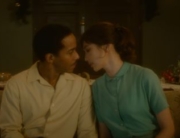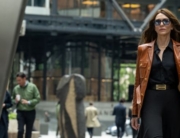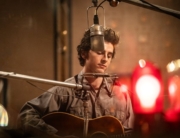![]() The plight of a donkey named EO illustrates the cruelty of man in the eponymous film by Jerzy Skolimowski (Essential Killing), the 84-year-old Polish director’s first feature after a seven-year absence. His bittersweet film is light on dialogue, but Michal Dymek’s striking cinematography and a mysterious, electronic score by Pawel Mykietyn elevate the mood piece that was loosely inspired by Robert Bresson’s Au Hasard Balthazar (1966).
The plight of a donkey named EO illustrates the cruelty of man in the eponymous film by Jerzy Skolimowski (Essential Killing), the 84-year-old Polish director’s first feature after a seven-year absence. His bittersweet film is light on dialogue, but Michal Dymek’s striking cinematography and a mysterious, electronic score by Pawel Mykietyn elevate the mood piece that was loosely inspired by Robert Bresson’s Au Hasard Balthazar (1966).
In an ersatz European road trip, we follow EO through many adventures meeting people from all walks of life. He reacts to circumstances with big liquid eyes that convey a range of feelings viewers project onto him, making him a perfectly identifiable protagonist, or at least the stand-in for one. Six donkeys are credited for the role of EO: Tako, Hola, Marietta, Ettore, Rocco, and Mela. Skolimowski thanked them by name at this year’s Cannes Film Festival, where the Polish-Italian co-production won the Jury Prize.
The film opens with EO as a circus performer where his handler, Kasandra (Sandra Drzymalska), caresses him and feeds him treats. The affection she feels is clearly a two-way street, as the donkey stays physically close to her. She tries to protect him against one of her rough peers, who views him as a brute to be used and abused, employing a whip to spur him as he pulls a cart into a junkyard. After animal rights activists brandish protest signs and picket the circus, the donkey is sent to a horse farm, leaving Kasandra bereft. (Later, as part of a celebration, EO wears a garland of carrots that give him easy access to a snack, one of the few moments of levity in the saga.)
He eventually finds himself in a donkey farm where small children enjoy interacting with the animals, even sitting atop them for a ride. When Kasandra locates EO there, he is magnetically drawn to her. It’s his birthday, and she’s brought gifts, including a sparkler that lights up the evening. A performer at heart, she dances before him, but eventually leaves, crying. Indomitable, EO breaks a fence to chase after her but ends up lost in a forest, braying. With glistening spider webs, the scene takes on a magical air of nature ruling the land, until a nocturnal hunter using a laser device discharges his weapon, and EO beholds the violence to one of his animal brethren. Here, and woven throughout, are dramatic photographic techniques: swooping drone shots, microscopic close-ups, and, most notably, a fiery red filter illuminating images. At times, the camera spins around, mimicking a dancer or windmill.
EO is on the move yet again and enters a quaint town where a fish tank in a pet store window catches his eye, until firefighters attempt to capture him with animal control poles. As before, the female of the pair scolds her male partner who might hurt the animal. Next comes a soccer team that considers him their lucky charm, but their idea of celebrating a win includes blowing smoke in EO’s face and giving him beer. The losing team comes for revenge and take their anger out on the donkey-turned-mascot in the most brutal scene of the film.
Battered and in an animal hospital, EO dreams of Kasandra’s loving touch, one of many reveries he has of his better days. A vet suggests putting him out of his misery, and soon he’s at an animal disposal site where all kinds of caged beasts are being electrocuted—EO is not above taking revenge on the exterminator. Again, he escapes, and after a misadventure with a heavy-metal-loving truck driver, EO’s carried away from a crime scene by an Italian man (Lorenzo Zurzolo) in a fedora, who asks his newfound sidekick, “Did I save you or have I stolen you?”
The man drives EO across borders to Italy, where the donkey finds himself on the lawn of a large estate, looking up at layered images of leafy trees. In one of the few all-human episodes, a countess (Isabelle Huppert) plays out a dramatic confrontation with EO’s erstwhile rescuer, a man who is not who he first seemed. (The odd but intriguing sequence of family power dynamics looks like a short film designed to entice Huppert into playing a passionate, plate-smashing role.)
Finally, EO joins a lineup of cattle en route to what might be his inevitable end. The scene is thankfully indirect, unlike Andrea Arnold’s documentary Cow from earlier this year—there have been quite a few “beast of burden” films in 2022, such All that Breathes, about saving black kites in India, and The Banshees of Inisherin, with a miniature donkey as a companion for a key character.
Many movie goers find cruelty to animals unbearable to watch, and it’s true, EO suffers and endures hardships. Nevertheless, the 86-minute film alternates difficult episodes with adventurous ones and avoids graphic displays of violence. It offers a welcome humanitarian perspective with sensory riches, in a profound, visually enthralling experience.







Leave A Comment